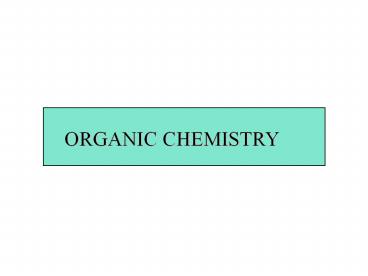ORGANIC CHEMISTRY - PowerPoint PPT Presentation
1 / 21
Title:
ORGANIC CHEMISTRY
Description:
ORGANIC CHEMISTRY 10 s millions organic compounds 1.5 million inorganic compounds 1. Carbon FORMS COVALENT BONDS SUMMARY Carbon forms covalent bonds Carbon bonds to ... – PowerPoint PPT presentation
Number of Views:768
Avg rating:3.0/5.0
Title: ORGANIC CHEMISTRY
1
ORGANIC CHEMISTRY
2
VITALISM
(prominent idea of the 1700s)
Vitalism was the belief that certain chemicals,
ORGANIC CHEMICALS, could only be made
by living organisms.
INORGANIC CHEMICALS
were found primarily in the earth as
mineral deposits, but could also be prepared by
man.
3
..
Friedrich Wohler (German), 1828
Critical Experiment ..
Synthesized Urea (organic) from ammonium
chloride and silver cyanate (inorganic)
inorganic
organic
.. defeated the vitalism idea
4
I challenge you to find a single item in this
lecture room, your dorm room, your car or your
house .. that hasnt seen the
influence of an organic
chemist
- paints, varnishes, waxes, finishes (acrylics,
latex, silicones)
- plastics (formica, vinyl, polystyrene,
polyurethane, PVC)
- adhesives (contact cements, epoxy resins,
cyanoacrylates)
- fabrics (nylon, acetates, synthetics, dyes,
brighteners)
- synthetic carpets, mats
- foods (packaging, coloring, preservatives)
- medicines, vitamins, pharmaceuticals
- gasoline, oils, lubricants, solvents
- paper, cardboard
- rubber, tires, elastomers
5
10s millions organic compounds
- 1.5 million inorganic compounds
6
(No Transcript)
7
WHY CARBON?
Why is carbon the chosen element on which to base
living systems?
8
1. Carbon FORMS COVALENT BONDS
1.2 BONDING PROPERTIES OF CARBON
9
1.2 BONDING PROPERTIES OF CARBON (continued)
Carbon is one of the few elements that can form
chains
C-C-C-C-C-C-C-C-C
10
1.2 BONDING PROPERTIES OF CARBON (continued)
3. Carbon IS TETRAVALENT (4 SINGLE
covalent bonds) sp3
11
The tetrahedral shape of carbon
109.5o
A carbon with 4 single bonds is known as sp3
12
1.2 BONDING PROPERTIES OF CARBON (continued)
3. Carbon IS TETRAVALENT (4 SINGLE
covalent bonds) sp3
13
UNIQUE PROPERTIES OF CARBON (continued)
4. COVALENTLY BONDS WITH A FEW OTHER COMMON
ELEMENTS
(H N O P S F Cl Br I )
How many covalent bonds are formed with these
atoms?
14
UNIQUE PROPERTIES OF CARBON (continued)
- SUMMARY
- Carbon forms covalent bonds
- Carbon bonds to itself
- Carbon forms 4 bonds (tetravalent)
- Bonds are single, double or triple
- Carbon bonds to other elements
15
ORGANIC INORGANIC
Liquid solid
Low melting/boiling pt High melting/boiling pt
Non-polar Polar
Volatile Non-volatile
Flammable Non-flammable
Low water solubility High water solubility
Non-electrolyte (molecular in water) Electrolyte (ionic in water)
16
- GENERAL CHEMISTRY TOPICS THAT APPLY TO ORGANIC
CHEMISTRY - Lewis structures (covalent compounds)
- VSEPR (covalent compounds)
- Shapes
- Bond angles
17
- Polarity of Organic Molecules
- electronegativity of bonded atoms
- shape and symmetry of polar bonds
- Intermolecular forces
- London forces
- Dipole-dipole
- H-boinding
- Acids and bases (pH)
18
ORGANIC CHEMISTRY
The chemistry of carbon / hydrogen containing
compounds
19
STUDY OF ORGANIC CHEMISTRY
- Learn elements involved
- Learn bonding
- Write molecular formulas
- Write structural formulas from molecular formulas
20
Determine physical properties, like water
solubility and mp and bp
STUDY OF ORGANIC CHEMISTRY (cont)
- Learn some chemical properties (reactions)
- Apply this knowledge to biologically important
compounds
21
The End































